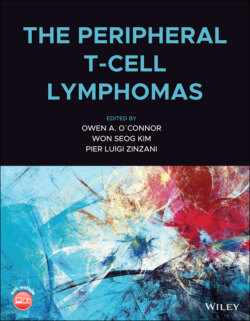Читать книгу The Peripheral T-Cell Lymphomas - Группа авторов - Страница 76
G17V RHOA Mouse Model
ОглавлениеTo determine effects of G17V RHOA expression, multiple independent G17V RHOA model mice have been established using either retroviral transduction [13], knock‐in [14], or transgene [15, 16] approaches. These G17V RHOA model mice did not develop AITL‐like lymphomas, although increase of Tfh cell populations [14, 15] and autoimmunity [15] were observed in some lines of mice. Therefore, the appearance of oncogenic phenotypes may require additional gene mutations.
Because the G17V RHOA mutations are almost always accompanied by loss‐of‐function TET2 mutations in human AITL samples [6], mice expressing the G17V RHOA mutant in Tet2‐null background were established by using distinct approaches [13–16]. Briefly, Zang et al. transduced Tet2‐null T cells with retrovirus harboring G17V RHOA, and they performed adoptive transfer of these cells into T‐cell receptor (TCR) α‐deficient mice [13]. Cortes et al. crossed G17V RHOAconditional knock‐in (cKI), Tet2conditional knockout (cKO), and CD4CreERT2 mice, in which tamoxifen induces expression of G17V RHOA mutant and deletion of Tet2 gene in T cells, and then transplanted bone marrow cells of these mice into irradiated C57BL/6 mice, followed by immunization with sheep red blood cells [14]. Ng et al. crossed G17V RHOA transgenic mice with Tet2 cKO x Vav‐Cre mice, lacking Tet2 gene in hematopoietic cells, and OT‐II TCR mice, followed by immunization with NP‐40‐Ovalbumin [15]. Nguyen et al. crossed G17V RHOA transgenic mice with Tet2cKO x Mx1‐Cre mice, lacking Tet2 gene in hematopoietic cells with injection of polyinosinic:polycytidylic acid (pI:pC) [16]. Model mice established by Zang et al. revealed skewed T‐cell differentiation such as increase of TFH cells and decrease of T regulatory cells, and abnormal expansion of CD4+ T cells [13]. Mice established by Cortes et al., Ng et al., and Nguyen et al. developed AITL‐like lymphomas after 25, 38, and 48 weeks, respectively [14–16]. Zang et al. also reported that TET2 loss and G17V RHOA expression synergistically inactivates FoxO1: Tet2 loss leads to increase of methylation in FoxO1 promoter that suppress its transcription in CD4+ T cells, whereas the G17V RHOA mutant elevates phosphorylation of FoxO1 and promotes its translocation from the nucleus to the cytosol, where it undergoes proteasomal degradation [13]. This agrees with findings of mTORc1‐associated gene expression by Ng et al. in G17V RHOA‐expressing tumor cells, as FoxO1 suppresses mTORc1 signaling [15]. Likewise, Cortes et al. reported that G17V RHOA activates PI3K‐mTORc1 signaling in CD4+ T cells dependent on ICOS‐ICOSL signaling [14]. Accordingly, tumor cell proliferation was inhibited by everolimus, a mTOR inhibitor [15] and duvelisib, a PI3K inhibitor [14], supporting the idea that ICOS‐PI3K‐mTORc1 signaling drives Tfh cell expansion in mice. Fujisawa et al. reported that hyperactivation of TCR signaling is an essential downstream event of the G17V RHOA mutant in vitro: the G17V RHOA mutant binds to and activates VAV1, a key component of TCR signaling [17]. Nguyen et al. reported that phosphorylation of VAV1 and activation of TCR signaling were also observed in murine tumor cells [16]. Dasatinib, a multikinase inhibitor effectively prolonged the survival of mice through inhibiting the TCR signaling pathway [16].
